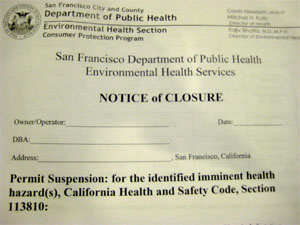Following last week’s report of a supposed outbreak of foodborne illness last month at the fancy Delfina eatery in San Francisco that was not reported to public health types, Inside Scoop SF reports that Delfina has now provided a statement, complete with dick fingers and exclamation marks.
This unfortunate incident is an isolated case and happened to a private party. There is no reason for any alarm or panic from our customers or throughout our city. We are confident that this is not a part of an epidemic or outbreak and are still working with the health department. We would like  to assure the public that there is no “tainted lettuce” outbreak in San Francisco as reported by SFist and then spread throughout the Internet. Below is our account of the incident:
to assure the public that there is no “tainted lettuce” outbreak in San Francisco as reported by SFist and then spread throughout the Internet. Below is our account of the incident:
A group of fifty rented out the restaurant for a private dinner with a set menu for their holiday party on December 10, approximately one month ago.
A day-and-a-half later we were informed that approximately half the group reported symptoms consistent with those of food poisoning.
We believe we narrowed the culprit down to three of the most likely menu items from the private party menu. We contacted the purveyors of the most suspect ingredients to inform them of what happened
After contacting the Department of Health we decided not to report it since it was a contained isolated incident.
At the end of the day, and as we expressed to the affected group, we take full responsibility and are truly sorry to be the cause of their discomfort. We are in the business of providing pleasure, not misery!

 unwelcome serving of its own: a cease and desist order from the San Francisco Department of Public Health.
unwelcome serving of its own: a cease and desist order from the San Francisco Department of Public Health. .jpg) and a lot of barf.
and a lot of barf. Committee: to require food establishments to “post the most current inspection scorecard in a window or other locations visible to the public.”
Committee: to require food establishments to “post the most current inspection scorecard in a window or other locations visible to the public.” inspections and help diners more easily find a restaurant’s health score.
inspections and help diners more easily find a restaurant’s health score..jpg) “If you’re going to San Francisco…” don’t expect to find restaurant inspection results easily.
“If you’re going to San Francisco…” don’t expect to find restaurant inspection results easily.